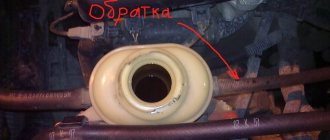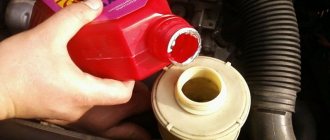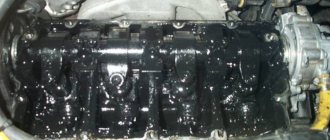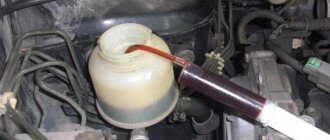Fluid replacement intervals
Having a car is not enough just to be able to drive it. It is necessary to know the replacement intervals for technical fluids. The trouble-free operation of all systems depends on this. Fresh fluid extends the life of the parts it comes into contact with.
Periodically, your car has to change the lubricant in the engine, gearbox, coolant and brake fluid.
Rules for replacing technical fluids
Each type of liquid has its own service life. Manufacturers have established certain intervals for their replacement.
The replacement procedure is not particularly difficult. Each driver can do this himself. The main thing is to know when and why to change fluids.
There are situations when the fluid needs to be replaced ahead of schedule. This can happen with engine oil, coolant or brake fluid.
Before replacing, you must purchase fresh fluid. In this case, you should know how much volume is needed. The choice should be made in accordance with the car manufacturer's recommendations.
If you do the replacement yourself, you need to prepare a container in advance where the old liquid will be drained. For work, you need to use special protective gloves to prevent liquid from getting on the skin of your hands.
All used fuel and lubricants products must be disposed of appropriately.
Power steering fluid change interval
Power steering ensures smooth and comfortable driving. For power steering to function, a sufficient volume of fluid in the system is necessary. To control its level in the engine compartment, there is a special tank with the corresponding MAX and MIN marks, or, if there are no inscriptions on the tank, then the tank cap performs the function of a measuring probe.
The normal power steering fluid level may vary depending on the specific vehicle model. During normal operation of the power steering system, there is no need to frequently add fluid, but in the event of a leak and depressurization, the fluid level may drop to a critically low level. The main signal that something is wrong with the steering system is a suddenly “heavier” steering wheel. In this case, it is necessary to check the fluid level and contact a service station to diagnose the operation of the entire steering system.
Many manufacturers claim that power steering fluid does not require replacement during the entire life of the vehicle. However, this statement is wrong. Power steering fluid, like any other technical fluid, has its own service life. Therefore, it is recommended to change the power steering fluid 1-2 times a year, depending on operating conditions. The maximum recommended interval for replacing power steering fluid is every 80 - 100 thousand km. mileage
Brake fluid change interval
A properly functioning braking system is the key to the safety of the driver and his passengers. It is necessary to monitor its serviceability regularly. For operation, brake fluid is poured into the system. Depending on the manufacturer, it may differ in composition and name. When choosing a fluid for your car, you should strictly adhere to the manufacturer’s recommendations. This applies not only to the brand, but also to the brake fluid replacement interval.
To control the brake fluid level, there is a reservoir with two marks: for minimum and maximum volume.
During normal operation of the brake system, topping up is not required. At the same time, it must be taken into account that brake fluid is hygroscopic. Over the course of a year, it can absorb 2-3% of water from the air. In this regard, corrosion will begin to appear on the inner walls of the parts over time, and the liquid itself will lose its properties. As a result, this can affect the operation of the entire braking system: braking efficiency will decrease, and the braking distance, on the contrary, will increase.
Sometimes it is not known when the brake fluid was last changed. This often happens when buying a used car. In this case, you can contact a service station, where they will check its quality using a special device and, if necessary, carry out a replacement procedure. In normal condition, brake fluid has a clear golden color.
The recommended frequency for replacing brake fluid is every 1-2 years, regardless of mileage, or after a mileage of 60,000 km (whichever comes first). You should not change the brake fluid more often, as this will not have any effect.
Coolant (antifreeze) replacement interval
Antifreeze or antifreeze is used as a coolant in cars. Less common is ordinary water, as it promotes corrosion.
The frequency of replacing the coolant may depend on the operating conditions of the vehicle. Monitoring the engine cooling fluid level is not difficult. To do this, there is an expansion tank in the engine compartment with two marks: minimum and maximum. The exact level can be monitored on a cold engine. If necessary, add coolant to the expansion tank. This has to be done more often than with other technical fluids, since the degree of evaporation of the coolant is very high.
If it is necessary to replace the antifreeze in a car, then this should be done only when the engine has cooled down sufficiently. It is strictly forbidden to open the radiator cap while it is hot.
It is not recommended to mix different types of coolants with each other.
If you are replacing the coolant yourself, then you need to choose the right type of fluid: antifreeze or antifreeze, and also check whether it is a concentrate that needs to be diluted with distilled water.
The frequency of replacing antifreeze in a car, as well as antifreeze, is every two to three years or after 60-70 thousand km. vehicle mileage.
Gearbox oil change interval
There are two main types of transmissions: manual and automatic.
The method for checking the oil level in them may differ depending on the design. Sometimes this requires taking the car to a service station. The service life of transmission oil in different cars is from 20 to 60,000 km. The manufacturer often indicates the timing of oil changes on the packaging.
The timing of the transmission oil change may be influenced by the operating conditions of the vehicle. If the gearbox overheats frequently, oxidative processes in the oil begin to activate. In this regard, tar deposits are formed. The lubricant begins to lose its anti-wear and extreme pressure properties.
External factors can also affect the rate of oil wear. If dust or water gets inside the unit, it will lose its lubricating properties.
Gearbox oil can be mineral or synthetic.
A more precise frequency of changing transmission oil depends on the design of the gearbox and the type of oil.
Synthetic oil for automatic transmission / manual transmission
- Under normal operating conditions, 60,000 km or every 2 years.
- Under severe operating conditions, 30,000 km or every year.
Mineral oil for manual transmission
- Normal conditions - 50,000 km / 2 years.
- Severe conditions - 25,000 km / 1 year.
Robotic gearboxes and CVTs deserve special attention. The required oil level in these units is extremely important for their normal operation.
In such boxes it is recommended to change the oil every 25,000 - 30,000 km. Many car owners adhere to this recommendation, regardless of the operating conditions of the car. It is especially important to observe this interval for older cars.
It is advisable to change the oil in the automatic transmission and variator at a service station. If you simply drain the lubricant from the unit, some of it will remain in the torque converter, pump and valve body. When pouring, fresh oil will mix with old oil and lose some of its properties.
Service stations often have special equipment for pumping oil out of the cavities of the unit.
Compliance with replacement intervals for technical fluids is vital for the normal functioning of vehicle components. Neglecting this will inevitably lead to unpleasant consequences.
What if you don’t change the power steering fluid?
The composition circulating in the structure constantly experiences temperature changes and therefore gradually loses its qualities. Metal microparticles formed as a result of natural wear and tear of control parts make their “mite” in this process. As a result, the car begins to listen poorly to the steering wheel.
The most radical result of untimely replacement of power steering fluid is jamming of the system, which can create an emergency situation.
How to completely change the power steering oil
You can change the fluid in Moscow by contacting any technical center, but you can do it yourself. Before pouring fresh composition, carry out preparatory work and prepare the following tools and devices:
- large disposable medical syringe or rubber bulb;
- 10mm wrench (preferably a socket wrench);
- a suitable container (you can use a regular one and a half liter plastic bottle);
- pliers;
- flexible hose with a diameter of 6-8 mm;
- jack and rags.
You will also need an assistant. Next, place the front of the car on a jack to facilitate the operation of the power steering and free rotation of the steering wheel. Cover nearby engine parts with a rag, including the power steering pump drive belt, to prevent oil from accidentally getting on them. Further:
- attach the hose to the syringe, unscrew the tank cap and lower the “structure” into it to remove the old liquid;
- remove the clamps and disconnect the hoses to remove the tank;
- pour out the remaining liquid and rinse the container and pipes;
- To ensure that the oil flows out of the system completely and quickly, ask an assistant to turn the steering wheel in both directions (there is no need to start the engine);
- lift the suction hose connected to the pump; you also need to add liquid into the pipe through the funnel - at the same time turn the steering wheel until clean and fresh oil appears from the return line;
- rinse the tank and install it in place, attaching the hoses and tightening the clamps;
- add fluid to the maximum level mark;
- turn the steering wheel, start the car and repeat the operation;
- when air bubbles appear in the tank, turn the steering wheel until they disappear;
- Turn off the engine and again add fluid to the maximum level.
Partial fluid change
Everything is much simpler here. At the first stage, perform the same operations: put the car on jacks to raise the front end and cover the nearby “territory” with rags. After:
- remove the old fluid with a syringe and add new fluid to the MAX level;
- start the engine and slowly turn the steering wheel in both directions until the end;
- you need to drain the oil, and if it is dirty, add it to the required level: repeat the operation until fresh fluid comes out.
Some probes have not two levels - MAX and MIN, but four: MAX COLD, MAX HOT. The first of them shows the maximum level on a hot power unit, the second - on a cooled one.
Choosing oil for power steering
In the international classification, any product for power steering is labeled as PSF. The liquid can have one of three colors:
- red;
- green;
- yellow.
This was done specifically to prevent mixing of formulations containing additives that do not tolerate each other. That is: green liquid cannot be combined with any others. Yellow oil can only be mixed with red oil. The best option (it’s better not to experiment!) is to fill in the same liquid recommended by the manufacturer to prevent the formation of clots and lumps, which will lead to dismantling, disassembling and cleaning the power steering. Here are some guidelines:
- for cars with automatic transmission - only red fluid;
- for cars with “mechanics” - only green oil;
- for both types of boxes - a yellow product.
Another point: the car manufacturer may recommend several types of fluids. It is important to follow the rule that you should not mix mineral oil with synthetic oil. Whatever liquid the system worked on previously should be filled in.
Important: both synthetics and mineral water can be red. These compounds (for example, Dexron II-IV, New PSF-3) are most often used in Korean-made cars, Toyota, BMW (before 1994), Chevrolet. Yellow liquids are more often poured into Mercedes, green (both synthetic and mineral) into VW and French cars (except Renault Duster).
Where can I get information about suitable power steering fluid?
Which power steering fluid is right for you? The answer to this question can be obtained in several ways:
- usually the type of power steering oil is indicated in the technical documents for the car,
- also the information that interests you is usually indicated on the oil tank cap,
- You can contact the dealership and ask the specialists working there.
You can do it differently. In this article you will find useful tips to help you decide on the choice of fluids for the power steering used in your car.











